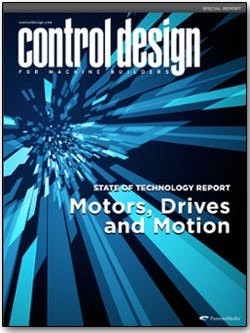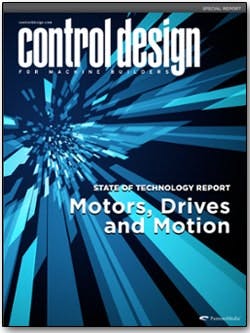As machine trends change, motion requirements stay unaffected
Machine building has seen an interruptive shift in how equipment is built and how it operates. From software and robotics to virtualization, simulation and the Industrial Internet of Things, the manufacturing landscape is shifting faster than ever.
But, despite all of the changes, motors and drives continue to play a major role in making machinery move.
In a February 2016 survey, Control Design readers identified usage and application trends in motion, drives and motor technology, reinforcing that, the more machines change, the more their motion requirements stay relatively unchanged.
More than two-thirds of respondents reported using servo motors, while almost half are using standard motors, and almost one-third are using stepper motors. Regarding efficiency motors, almost half are using high-efficiency, and one-fourth are using premium-efficiency motors.
The vast majority (86%) of respondents who use servo motors said they’re mostly digital-drive technology, with only 14% using analog. And almost 40% of respondents using stepper motors use open-loop steppers, with the remainder using closed-loop.
For performance characteristics of their drive systems, 67% of respondents said position control was most important, while 42% identified speed control, and 27% indicated it was torque control.
Respondents using a digital bus indicated use of EtherNet/IP (42%), followed by CAN/CANopen, SERCOS/SERCOS III, EtherCAT and Profinet, all hovering in the 9-to-13% range. Powerlink, DeviceNet and CC-Link all showed up at 5% or lower.
Our 2016 State of Technology Report on motors, drives and motion explores in greater detail the trends that have shaped motion control, the fundamentals of the technology, and real-life examples of implementation that have proven successful. Drawn from recent articles published in Control Design, this special report includes articles on emerging developments, basic primers and motion-control examples illustrating the latest technology in action. We hope that you find it useful.
About the Author
Mike Bacidore
Editor in Chief
Mike Bacidore is chief editor of Control Design and has been an integral part of the Endeavor Business Media editorial team since 2007. Previously, he was editorial director at Hughes Communications and a portfolio manager of the human resources and labor law areas at Wolters Kluwer. Bacidore holds a BA from the University of Illinois and an MBA from Lake Forest Graduate School of Management. He is an award-winning columnist, earning multiple regional and national awards from the American Society of Business Publication Editors. He may be reached at [email protected]

Leaders relevant to this article:


